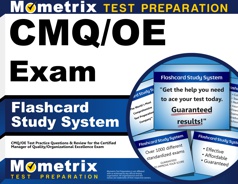The American Society for Quality (ASQ) administers the Manager of Quality/Organizational Excellence (CMQ/OE) certification exam to assess the knowledge and skills of those seeking to lead and champion process-improvement initiatives.
Click “Start Test” above to take a free CMQ/OE practice test, and check out our premium-quality CMQ/OE test prep resources by clicking the links below!
Exam Eligibility
To be eligible for this exam, you must have at least 10 years of experience in at least one area of the CMQ/OE Body of Knowledge, 5 years of which must be in a decision-making position.
Depending on your level of education, your work experience will be partially waived.
| Level of Education | Years of Experience Waived |
|---|---|
| Technical/trade school diploma | 1 year |
| Associate degree | 2 years |
| Bachelor’s degree | 4 years |
| Master’s or doctorate | 5 years |
CMQ/OE Exam Outline
The CMQ/OE exam contains 180 multiple-choice questions, 15 of which are unscored, and you will be given a time limit of 4 hours and 18 minutes. ASQ uses the unscored questions to validate questions for future versions of the exam.
The questions on the exam are grouped into six levels of complexity.
You must recall terms, methods, patterns, definitions, sequences, facts, materials, etc.
Understand
You must comprehend reports, tables, regulations, descriptions, directions, diagrams, etc.
Apply
You must know how and when to use theories, procedures, ideas, formulas, principles, etc.
Analyze
You must separate information into its constituent parts and recognize the relationship between these parts and how they are organized.
Evaluate
You must evaluate proposed ideas and solutions by holding the proposals to set criteria and standards.
Create
You must reveal a pattern or structure that was not initially clear given a set of parts or elements.
The exam is split into seven sections, collectively called the “CMQ/OE Body of Knowledge.”
I. Leadership (28 questions)
The questions in this section are designed to assess your leadership knowledge and abilities in the following areas:
Organizational Structure
Define and describe organizational designs and the effect that hierarchical structure can have on an organization.
Leadership Challenges
Describe typical roles, competencies, and responsibilities of leadership positions.
Describe typical roles, competencies, and responsibilities of management positions.
Overcome organizational roadblocks, assess global change impacts, achieve desired change levels, and review outcomes.
Motivate employees and sustain enthusiasm. Use negotiation techniques to enable differing parties to recognize and achieve common goals.
Empower individuals and teams, identifying typical obstacles to empowerment and overcoming them.
Teams and Team Processes
Identify different types of teams and their purposes.
Explain the effect that the stages of team development have on leadership style.
Apply basic team-building exercises to enhance team introductions and membership.
Describe typical team support roles, as well as various member and leader responsibilities.
Evaluate team performance regarding goals and objectives.
ASQ Code of Ethics
Identify behaviors and actions that comply with the ASQ code of ethics.
II. Strategic Plan Development and Deployment (22 questions)
The questions in this section are designed to assess your plan development and deployment knowledge and abilities in the following areas:
Strategic Planning Models
Define and describe basic strategic planning models.
Business Environment Analysis
Analyze the strengths, weaknesses, risks, threats, and opportunities of an organization.
Describe various forces that drive strategic plans.
Differentiate the needs, objectives, and perspectives of internal and external stakeholders, and ensure the organization’s objectives align with the stakeholders’ objectives.
Describe the long-term and short-term influences changes in technology can have on strategic planning.
Describe the effects that influence the internal capabilities of an organization.
Describe the potential influence of regulatory and legal factors on strategic plans.
Strategic Plan Development
Identify basic characteristics of various tactics and how they are linked to strategic objectives.
Evaluate current resources to ensure they are available and deployed to support strategic initiatives.
Ensure measurements are aligned with strategic goals.
Apply continuous improvement initiatives to drive performance outcomes.
III. Management Elements and Methods (31 questions)
The questions in this section are designed to assess your management knowledge and abilities in the following areas:
Management Skills and Abilities
Evaluate and use basic management principles.
Describe management theories and management styles, as well as the factors that influence management styles.
Describe the interdependence of an organizations areas and how they influence processes and outputs.
Apply elements of human resources to support ongoing professional development.
Interpret and use a variety of financial tools, manage budgets, and analyze project risks and priorities.
Identify risks that may occur throughout the organization.
Use knowledge management techniques to identify core competencies that create a system and culture for collecting and sharing knowledge among workers, competitors, stakeholders, and suppliers.
Communication Skills and Abilities
Apply various modes of communication used within organizations and identify factors that can inhibit clear communication.
Use empathy, tact, objectivity, and friendliness, as well as open-minded and non-judgmental communication methods.
Identify key communication challenges across different time zones, languages, business practices, and cultures, and present ways of overcoming them.
Identify the effects of technology on communications and deploy appropriate communication methods within virtual teams.
Project Management
Use project management methodology and ensure projects are aligned with strategic objectives.
Use tools to plan projects and estimate related costs.
Use tools to monitor project activity against the project plan.
Document projects using written procedures and project summaries.
Quality System
Develop and monitor the quality mission and policy.
Develop and deploy the quality plan and ensure that it is documented and accessible.
Evaluate the effectiveness of the quality system.
Quality Models and Theories
Apply the requirements and basic principles of ISO-9000-based standards used to support quality management systems.
Describe common elements of performance excellence models and how their criteria are used as management models to improve processes.
Differentiate a variety of methods such as benchmarking and continuous improvement.
Apply basic methodologies proposed by quality leaders.
IV. Quality Management Tools (30 questions)
The questions in this section are designed to assess your knowledge and abilities in the following areas:
Problem-Solving Tools
Evaluate output from various tools.
Evaluate tools such as PDCA, root cause analysis, and six sigma DMAIC.
Use various exercises for creative decision-making and problem-solving.
Distinguish between appraisal, prevention, external, and internal failure cost categories.
Process Management
Describe the establishment, monitorization, and measurement of process goals.
Analyze a process and evaluate its effectiveness on the basis of work instructions, procedures, and other documents.
Use a variety of lean tools.
Define key concepts of the theory of constraints.
Measurement: Assessment and Metrics
Use statistical techniques to identify what, when, and how to measure projects and processes.
Describe basic sampling techniques and identify why and when sampling is appropriate.
Calculate basic statistics.
Understand basic measurement terms and the difference between reproducibility and repeatability in gauge R&R studies.
Interpret charts and graphs to identify seasonal, environmental, and cyclical data trends.
Analyze data to distinguish between special and common cause variation.
Recognize process capability and performance indices.
Describe basic reliability measures and understand the value of estimating reliability to meet requirements.
V. Customer-Focused Organizations (21 questions)
The questions in this section are designed to assess your knowledge and abilities in the following areas:
Customer Identification and Segmentation
Define internal customers and describe the impact of an organization’s treatment of internal customers on external customers.
Define external customers and describe their impact on products and services.
Assess the process of customer segmentation and its impact on aligning service and delivery to meet customer needs.
Identify subjective information.
Customer Relationship Management
Use quality function deployment to capture the voice of the customer and examine customer needs.
Develop systems to capture positive and negative customer feedback and experiences.
Demonstrate strategies that support customer service principles.
Monitor priorities to avoid or resolve conflicting customer requirements and demands.
VI. Supply Chain Management (17 questions)
The questions in this section are designed to assess your knowledge and abilities in the following areas:
Supplier Selection and Approval
Outline criteria for selecting, approving, and classifying suppliers.
Supplier Risk Management
Assess and manage supplier risk.
Supplier Communications
Implement specific communication methods with suppliers.
Supplier Performance
Assess and monitor supplier performance in terms of service levels, cost, delivery, and quality.
Supplier Improvement
Define and conduct supplier audits, evaluate corrective action plans, provide feedback, and monitor process improvements.
Supplier Certification, Partnerships, and Alliances
Appraise and implement supplier certification programs that include process reviews and performance evaluations.
Supplier Logistics and Material Acceptance
Describe the impact purchased products and services can have on final product assembly or total service package.
VII. Training and Development (16 questions)
The questions in this section are designed to assess your training and development knowledge and abilities in the following areas:
Training Plans
Develop and implement training plans that are aligned with the organization’s strategic plan and general business needs.
Training Needs Analysis
Use various tools and techniques to identify and assess training needs.
Training Materials, Development, and Delivery
Use various tools, methodologies, and resources to develop training materials and curriculum that address adult learning principles.
Training Effectiveness and Evaluation
Assess training effectiveness and make improvements based on feedback.
Check Out Mometrix's CMQ/OE Study Guide
Get practice questions, video tutorials, and detailed study lessons
Get Your Study Guide
Registration
To register for the exam, you must submit an application online via the ASQ website. Your application should include any necessary eligibility documentation, as well as the $568 examination fee ($468 for ASQ members).
Once ASQ approves your application, you will receive a confirmation email, which includes instructions on scheduling your examination with Promteric.
Test Day
The CMQ/OE exam is administered at Prometric testing centers across the country. You should arrive at the testing center about 30 minutes before the scheduled exam time. If you arrive late, you will not be able to take the exam.
When you arrive, you will be asked to provide a valid, government-issued photo ID. If you forget to bring your ID or if your ID is invalid, you will not be allowed to take the exam.
Before you enter the testing room, you will be asked to leave all personal items in an assigned locker or leave them in your car.
Once you are in the testing room, you will be given a four-function calculator, a small whiteboard, dry-erase markers, and noise-canceling headphones. After the exam begins, you will be allowed to take a break. However, the timer will not be paused during your break.
How the Exam is Scored
Your final score is determined using a scaled scoring system, in which your raw score (the number of questions you answered correctly) is converted to a scaled score using a modified version of the Angoff method. Your final scaled score must be at least 550 to pass the exam.
You will receive a pass/fail notification the day you take the computer-based exam. You can also access your score report 7-10 days after testing.
Retaking the Test
You can re-take the exam as many times as you would like, within a 2-year period. If you re-take the exam outside this 2-year period, you must submit a new application.
Check Out Mometrix's CMQ/OE Flashcards
Get complex subjects broken down into easily understandable concepts
Get Your Flashcards
FAQs
Q
How many questions are on the CMQ/OE exam?
A
There are 180 multiple-choice questions on the exam.
Q
How long is the CMQ/OE exam?
A
The time limit for the exam is 4 hours and 18 minutes.
Q
What is the passing score for the CMQ/OE exam?
A
To pass the exam, you must achieve a minimum scaled score of 550.
Q
How much does the CMQ/OE exam cost?
A
The examination fee is $$468 for ASQ members and $568 for non-members.
